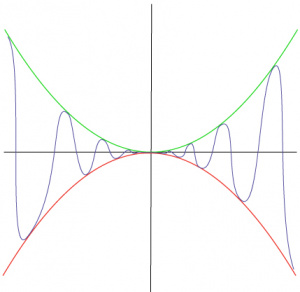Difference between revisions of "Squeeze Theorem"
| Line 1: | Line 1: | ||
The '''Squeeze Play Theorem''' (also called the '''Squeeze Theorem''' or the '''Sandwich Theorem''') is a relatively simple [[theorem]] that deals with [[calculus]], specifically [[limit]]s. | The '''Squeeze Play Theorem''' (also called the '''Squeeze Theorem''' or the '''Sandwich Theorem''') is a relatively simple [[theorem]] that deals with [[calculus]], specifically [[limit]]s. | ||
| − | [[Image:Squeeze theorem example.jpg]] | + | [[Image:Squeeze theorem example.jpg|thumb|Squeeze Theorem]] |
==Theorem== | ==Theorem== | ||
Revision as of 16:21, 1 May 2008
The Squeeze Play Theorem (also called the Squeeze Theorem or the Sandwich Theorem) is a relatively simple theorem that deals with calculus, specifically limits.
Theorem
Suppose ![]() is between
is between ![]() and
and ![]() for all
for all ![]() in the neighborhood of
in the neighborhood of ![]() . If
. If ![]() and
and ![]() approach some common limit L as
approach some common limit L as ![]() approaches
approaches ![]() , then
, then ![]() .
.
Proof
If ![]() is between
is between ![]() and
and ![]() for all
for all ![]() in the neighborhood of
in the neighborhood of ![]() , then either
, then either ![]() or
or ![]() for all
for all ![]() in the neighborhood of
in the neighborhood of ![]() . Since the second case is basically the first case, we just need to prove the first case.
. Since the second case is basically the first case, we just need to prove the first case.
If ![]() increases to
increases to ![]() , then
, then ![]() goes to either
goes to either ![]() or
or ![]() , where
, where ![]() . If
. If ![]() decreases to
decreases to ![]() , then
, then ![]() goes to either
goes to either ![]() or
or ![]() , where
, where ![]() . Since
. Since ![]() can't go to
can't go to ![]() or
or ![]() , then
, then ![]() must go to
must go to ![]() . Therefore,
. Therefore, ![]() .
.










